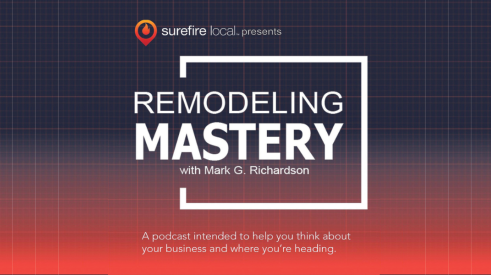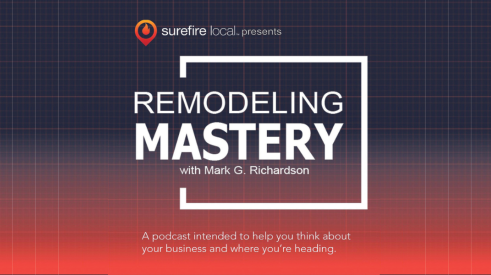How often have you done what you consider is your very best sales pitch? You were well-received and the prospect appeared to like your company and how you proposed to complete the project. Yet you end up leaving the prospect’s home without a sale.
Are you wondering what you missed? What could have been said or done to get the contract? What are the most successful closing processes?
You are not alone when it comes to asking these questions. Selling home improvement projects and more specifically “closing the sale” requires some analysis.
Closing the sale is not something that happens at the end of a presentation. It is an ongoing process that starts with your first contact with a prospect. If you knew what the prospect was really thinking instead of instinctively responding to what they’re saying, knew their planning strategy, or knew the extent of the competition, imagine how your sales presentation would improve and how much easier it might be to close the sale.
Let’s debunk some of the myths and old-fashioned beliefs about closing while also supporting some of the most successful methods.
Good closers are either artists or con men
This is a longstanding myth. Yes, some sales organizations attract con men. Incidentally, the prefix con comes from the word confidence. The same judgment is frequently raised with a strong “closer” and is unfairly judgmental.
In addition to con men, which are in the minority, there are salespeople who are charismatic or who have unique personalities that make them believable. There are also those who exaggerate, are untruthful, or have weak or foolish habits. But for the most part, good closers have been trained in the art of understanding their prospects. This is when closing is a science and not an art. If you do not fit into the profile of a strong closer, don’t prejudge what you do not fully understand.
The one-call close is dead
The art of “one-call closing” is ill-defined and improperly labeled. Those who don’t understand the science of selling are often quick to appraise a competitive company as using unethical standards to produce sales.
For clarity, a one-call close does not imply that upon the first meeting with a prospect, “bingo”, a sale is made. If you’re in a business that sells sizeable contracts and includes designs, plans, elaborate pricing, and multiple trades, it is often necessary to visit the site of the project more than once, gathering data about the architecture, building codes, and the prospect’s intent and needs.
Check out a free study on the 7 Myths of In-Home Selling at www.daveyoho.com/mp3.php.
However, once you reach the point of fully presenting the project, the proposal, and the price, that’s when an attempt is made to get a sale. That is referred to as a “one-call close.”
Those selling single product services, roofing, bath refitting, cabinet refacing, siding, windows, and similar have less elaborate needs in the planning stage; however, when the price is quoted that’s the time to ask for the order.
That’s what makes it a “one-call close.” If you don’t follow these practices, don’t judge it until you fully understand it.
Two-step closing takes the heat out of getting a sale
I don’t know where this myth came from. The concept is this: Once you quote the price and the prospect doesn’t buy, you rest your case and hope the prospect will favor you with a sale and/or you get back into the prospect’s home to renegotiate.
The truth is if your product measures up to what you say it is and does, your practices meet the needs and value system of your prospects, you have done your best presentation, and you’ve done more listening than talking, then you’ve earned the right to ask for the order (see trial closes which follow).
You may not always get it, but when done simply it can work and is a better option than not asking at all and hoping something will happen later.
It takes big discounts to close large sales
Between 1960 and 1980, it was a common practice to use a discount or a “drop” at the conclusion of a sale to create an incentive to “buy now.”
As the size of individual contracts grew, seemingly so did the size of the discounts. As an example, often when a list price of $20,000 is questioned or resisted the close starts with a 15-percent advertising allowance or similar.
To learn more about big discounts to close sales and how this method of selling does not work, visit Dave Yoho’s blog entitled “The Big Drop is a Big Flop” at www.daveyoho.com.
Suddenly the $20,000 sale became $17,000. If this still met resistance another 10 percent became available. Now you have a $15,300 contract and the final ploy might be to invoke, “I’ll call my manager” (where another 5 percent discount is offered). Now you’re down to $14,535.
The customer is supposed to buy into a $5,500 discount from the original price, which raises two questions:
Did the customer believe the validity of the original $20,000 price?
If that was the case, why is that customer still looking for a better price and/or signs a contract and rescinds it two days later claiming the price was too high?
The tactic of offering this incentive was often an amount of $500-$800 to get an immediate contract approval, and it made sense. The sequence of big drops does not make sense.
Should incentives be offered to get an order?
Resoundingly yes, however, it has to be credible and offered after the customer’s needs and values are met. With modern advertising techniques this prospect was often created with the use of a “promise.” Examples include:
- “For a limited time”
- “During the month of December”
- “Closing our year”
This is a legitimate incentive to get you and the prospect together. If you have additional incentives to close the sale such as 12 months free financing or 24 months same as cash, this is an incentive your company is paying for in order to get that sale while benefiting the customer, and should be used as a closing tool.
How does this relate to scientific selling? First, stop telling. Selling requires a lot of listening, and processing information equates with helping and caring. The “walk around” to evaluate the project is better named “needs assessment.”
When did the prospect first consider the project? What other options have they considered? What can you point out to them that they did not perceive on their own? What do they really know about the products and options that go into their project, and how closely did they examine the conditions that prompted them to call your company?
In scientific sales training the salesperson is conditioned to develop rapport, a feeling developed by the prospect, and prospects tend to listen more to people who in turn listen to them. Rapport stems from gathering information and presenting your product in a manner that makes others feel comfortable.
Value versus price, a powerful closing tool
When you’ve done your job effectively your prospect comes to one of two conclusions:
- The value of what you’re asking for the contract exceeds the price
- The price exceeds the value
If you get the former rather than the latter, now you’re in a position to attempt the close. To attain this level, we developed a method called “The Total Offer Concept.” This concept includes aftermath of a complete needs assessment and an evaluative product presentation followed by a price presentation. The project is broken down and includes components of your services beyond labor and material—various insurance coverage, design, permits, supervision, service, warranty—each defined as part of the “total offer.”
This is followed by asking for affirmation on the value of each element of the offer, which is then followed by a “trial close.”
Trial closes
Trial closes are exactly what they imply. One or a combination of these components could lead to a sale or open the door to receiving additional information, which might lead to closing. Other than the price or the ability to afford the entire project, is there any other issue that can be defined?
Your client indicates they would continue to live in their home for another 10 to 12 years. How does their investment look when spread out over that period? What would need to exist for us to start the paperwork for the next step? Is the client considering the cash or the budget method for payment? Is the client interested in your 12 months same as cash offer?
Just imagine the information that will come from a trial close even if you can’t immediately close. Essentially, the close requires you put into play what was learned from needs assessment, product presentation, and other closing questions that puts you in position to “ask for the order.”
These are but a sampling of trial closes which have proven extremely workable for rookie or veteran salespeople.
When all else fails—the doorknob close
You’ve exhausted all of your suggestions, exhortations, and trial closes. As you’re about to leave with your hand on the doorknob look at your prospects directly and say:
“We’ve spent a lot of time together today and I’m under the impression that you like our company, its methods, and the product and installation system which we utilize. So I have one question, can you help me?” Then ask: “What would need to exist for us to be able to do the paperwork and start this project for you as soon as possible?”
Try it, you’ll lose nothing and may gain a sale. PR
--
Dave Yoho is the president of Dave Yoho Associates, Fairfax, Va., and founded his consulting company in 1962. It is the oldest, largest, and most successful consulting company in the industry. They also produce the best-selling recorded (CD) series “The Science of Successful In-Home Selling” and the Web-based video training series “Super Sales Training.” Visit www.daveyoho.com or call 703.591.2490. For more information on presentation development and additional information on sales presentations, consult his blog www.daveyoho.com/wordpress.
Debunking the myths and old-fashioned beliefs about closing.
Add new comment
Related Stories
How to Get More Leads with a Stronger Remodeling Brand
Discover how to build a strong brand for your construction company, and learn key strategies to differentiate and attract better leads
How to Increase Your Odds of Closing Remodeling Sales
Use these tips to hone your sales process and grow close ratio
Building A Small Projects Division from the Ground Up
Through hard work and careful strategy, Harth Home Services has seen big growth
A Mindset of Serving Others
A research study shows surprising results about what makes us take ownership of our work.
10 Questions to Identify Sales Weaknesses
Mark Richardson runs you through a proper fitness check-up—for you and your sales team, that is.
How to Communicate with Today's Cautious Remodeling Client
Amid economic skepticism, Americans continue to spend. Now, how can you get them to spend on remodeling?
7 Tips to Lower Remodeling Costs
As material and labor prices spiral out of control, many homeowners are putting the brakes on remodeling projects. Use these guidelines to bring down costs.
How to Ease Client Fears and Take Control of the Remodeling Process
Industry advisor Mark Richardson offers seven ways to control your client's fantasy of remodeling and, ultimately, minimize their fears and enhance their understanding
3 Things I Learned from a Day with Normandy Remodeling
How Normandy uses numbers to motivate and the power of their showrooms
Today’s Consumer is Your Biggest Competitor
Understanding the real competitor allows you to sharpen the correct skills













